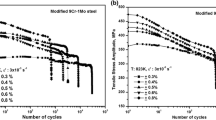Conclusions
-
1.
Lowering the temperature from 20 to −140°C produces an increase in strength and a reduction in ductility of low-carbon steels during low-endurance fatigue. At the same time the ability of such steels to resist deformation and fracture increases.
-
2.
The endurance of low-carbon steels in the temperature range investigated is controlled by cyclic creep phenomena; to estimate it at any given temperature, it is sufficient to know three values; the reserve of ductility of the material εf, the rate at which it is exhausted V, and the extent ξ to which the reserve of ductility has been exhausted during the steady-state creep.
Similar content being viewed by others
Literature Cited
A. P. Ruble' and V. A. Strizhalov, “Apparatus for investigating low-endurance fatigue of alloys at low climatic temperatures under pulse tensile loads,” Probl. Prochnosti, No. 7 (1974).
V. A. Strizhalov, “Investigation of the laws of the transition from quasi-static to fatigue fracture of light alloys during low-endurance fatigue,” Probl. Prochnosti, No. 5 (1974).
E. Yanke, F. Emde, and F. Lesh, Special Functions [Russian translation], Nauka, Moscow (1968).
Additional information
Institute of Strength of Materials, Academy of Sciences of the Ukrainian SSR, Kiev. Translated from Problemy Prochnosti, No. 1, pp. 11–15, January, 1976.
Rights and permissions
About this article
Cite this article
Strizhalo, V.A., Rubel', A.P. Low-endurance fatigue of low-carbon steels at low (climatic) temperatures. Strength Mater 8, 8–12 (1976). https://doi.org/10.1007/BF01528204
Received:
Issue Date:
DOI: https://doi.org/10.1007/BF01528204




